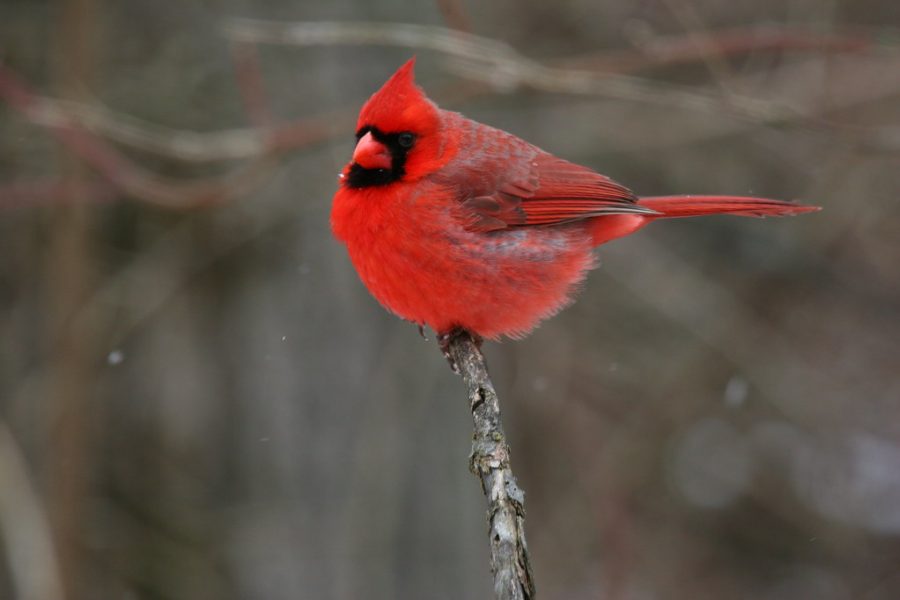If you live in New England, you may know the famous “pee-o” call of the Northern cardinal. The streak of red flashing through the sky is a common sight in backyards. However, it is actually native to the south, but due to climate change, the species has become common up north.
In a 2018 report from the Intergovernmental Panel on Climate Change found that climate change has led to a 1.5 degrees Celsius increase in global temperatures above preindustrial level. David King, a wildlife biologist from the University of Massachusetts found that this increase has caused bird species, such as the Northern cardinal, to migrate farther north.
According to King, increased global temperatures are causing plants to flower sooner. This means that insects that feed on these plants will also come out sooner. Birds feed on these insects and fruiting plants when they migrate back to the northeast in the spring and summer. Their timing is becoming out of sync as insect and fruits peak earlier than usual.
For birds, migration is as simple as ingrained reflexes. They migrate when the temperature is right, but increased global temperatures are causing some species to delay their departures.
Madeleine Rubenstein is a biologist and presidential management fellow with the United States Geological Services National Climate Change and Wildlife Center. She works to produce national level research on impacts of climate change on fish and wildlife and believes climate change is affecting migratory birds.
“Changes in phenology are one of the clearest indicators of climate change of any ecological system,” Rubenstein said.
According to Rubenstein, birds take cues from temperature and precipitation in order to determine when they should migrate. Climate change, she said, is affecting these natural patterns.
“If you look at the same species of bird in the same location, you’ll notice [the species] has started to arrive earlier,” Rubenstein said.
The changes in temperature and precipitation mean that plants are at peak bloom earlier than usual, according to Rubenstein. If birds are timing migration with this early budding, there won’t be a problem. If they can’t, then populations will start to decrease.
Avid bird-watchers may have noticed a decline in Pine warbler populations, for example. The Pine warbler has been shifting north over the past 20 years, according to Audubon’s climate report. If this trend continues, bird watchers can expect to hear less of their notable rattle calls. Instead, they may hear more southern bird calls, such as the call of the Tufted Titmouse or the red-bellied woodpecker, as these species move north.
King said the first time he heard a red-bellied woodpecker in New England was in 1990.
“My friends and I went to a pond in Connecticut to look for waterfowl,” King said. “On the way, we heard a red-bellied woodpecker and nearly drove off the road.”
The Tufted Titmouse is also new to this area.
“The first time I saw a Titmouse, I didn’t even know what it was,” King explained.
Blackpoll warbler species are also declining in the northeast. They migrate to South America in the winter, which requires a three-day journey over the ocean. Flying for three days straight requires a lot of energy, which these birds get from insects and berries.
Other environmental problems are causing bird populations to decline. According to Bill DeLuca, an environmental conservationist and research fellow at UMass, increased rainfall has a negative impact on waterfowl.
“High rain means more nutrients are entering the water,” DeLuca said, referring to the process of runoff. “This lowers water bird integrity and produces more generalists.”
More intense and frequent storms make it difficult for birds to survive when they migrate, especially along the Caribbean, according to DeLuca.
DeLuca says you can see population distributions change along mountain elevations. Birds will move up mountain slopes to different climate zones as temperatures increase.
“Low-elevations warblers like Black Bornean warblers, redstarts and ovenbirds are shifting up slope,” said DeLuca. “They’ve shifted 100 meters north over the past 20 years.”
Shorebirds are a whole other migratory system. These birds are being affected by declining food sources, DeLuca noted.
“Horseshoe crab populations are tanking, which shorebirds are really tied to,” he said. Ocean acidification, overfishing and sea level rise are lowering species populations in the ocean.
In the coming years, black-capped chickadees will be less common, according to King.
“As black-capped chickadees move north, so will Carolina chickadees,” said King. Carolina chickadees are native to the south and will continue to move north. “We’ll probably start to see those more often.”
We may also see more worm-eating warblers and cerulean warblers, according to DeLuca.
Bird species provide more than just aesthetic or ecological benefits. Rubenstein said for her, the spiritual connection is important as well.
“It’s really cool that I’m sitting here in Maryland and someone could be sitting out there in Honduras seeing the same exact birds,” she said.
Kaleigh Keohane can be reached at [email protected].




















Jonathan Haarstick • Apr 18, 2019 at 8:15 pm
What a maaastapiece! Beautiful!
Nick • Apr 18, 2019 at 5:44 pm
This is so cool! I can’t wait to share it in my eco-rep class; it’s a 2 credit seminar that meets once a week, where we discuss sustainability and solutions!
Jackie • Apr 18, 2019 at 5:37 pm
gr8 article big fan of ur work